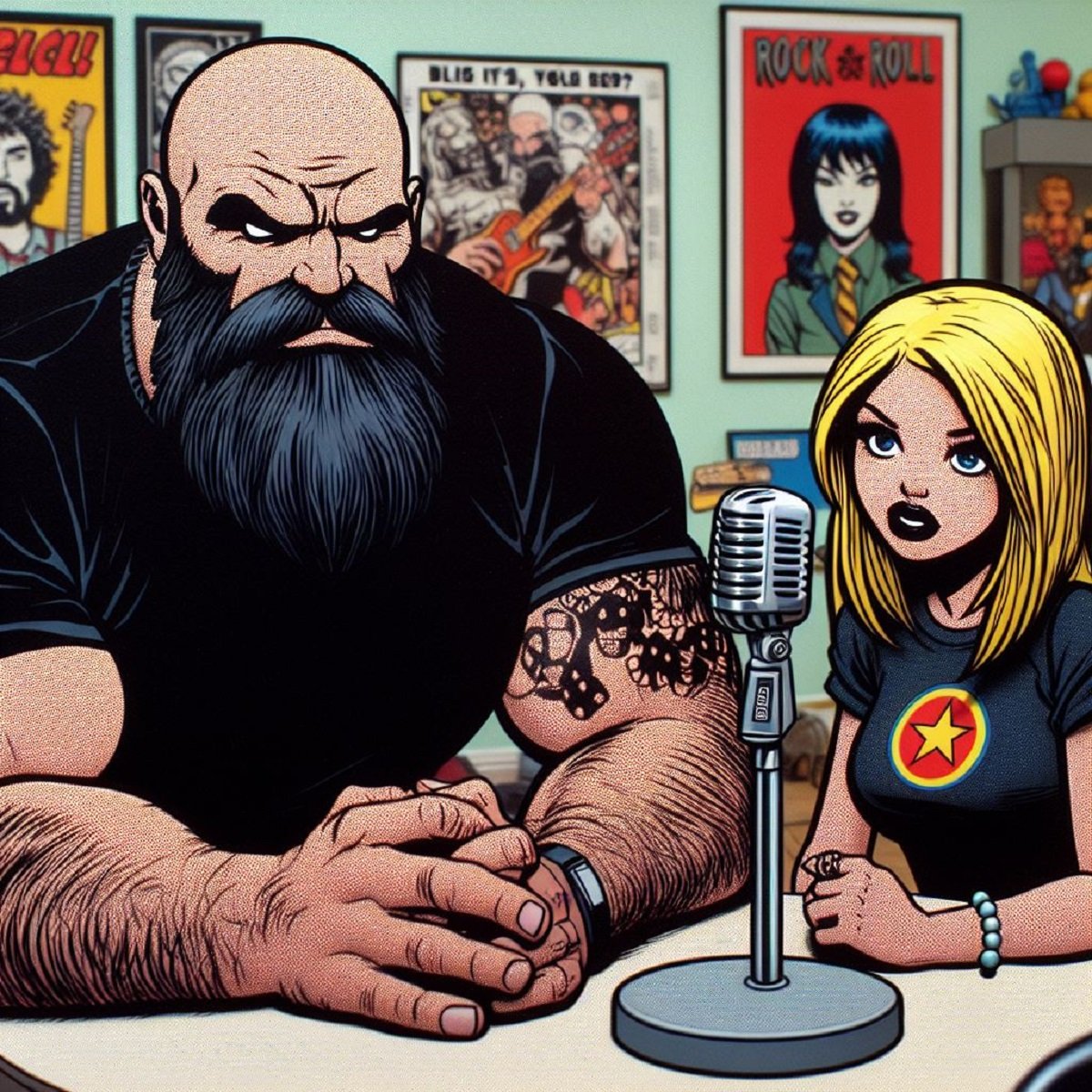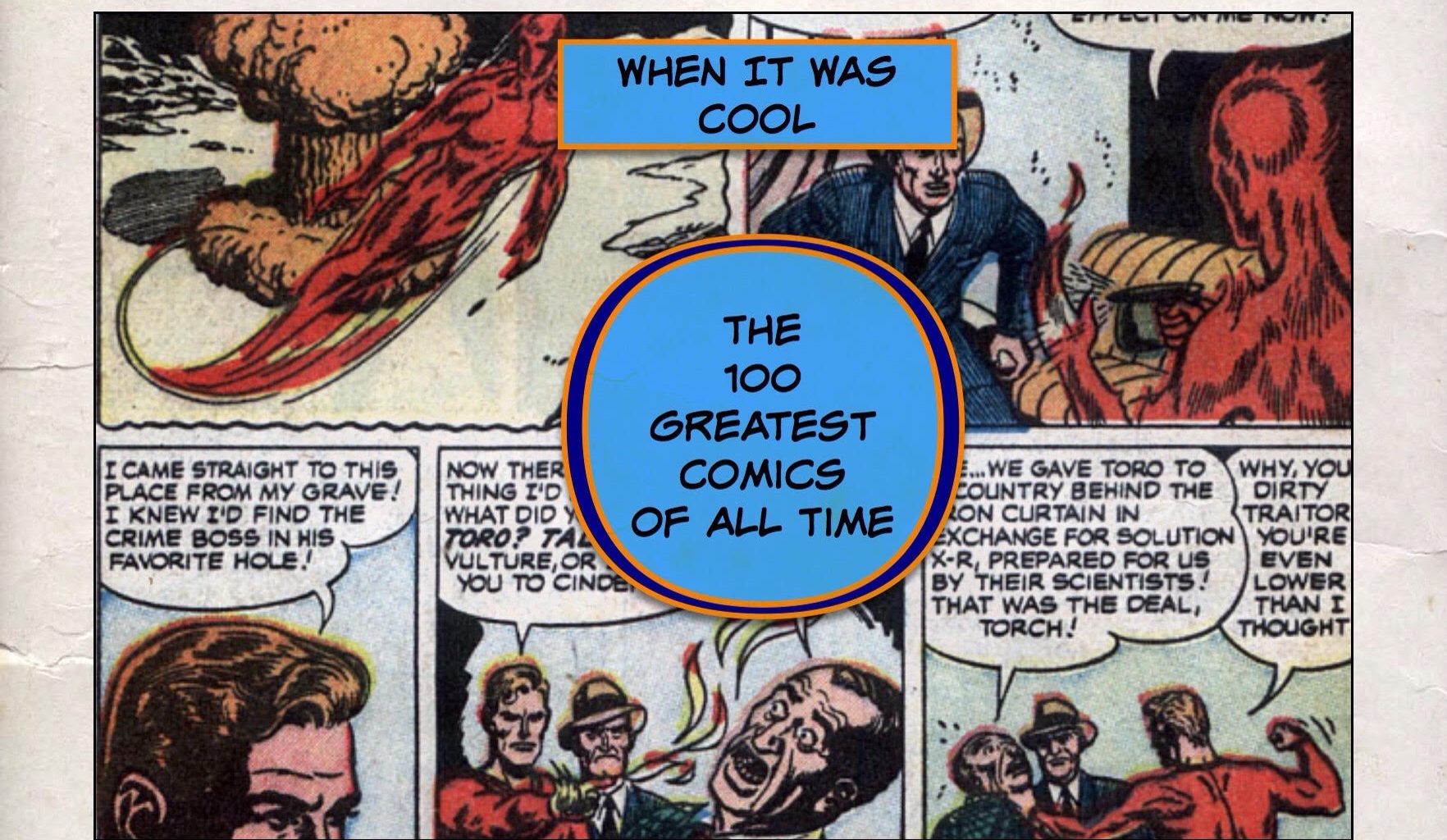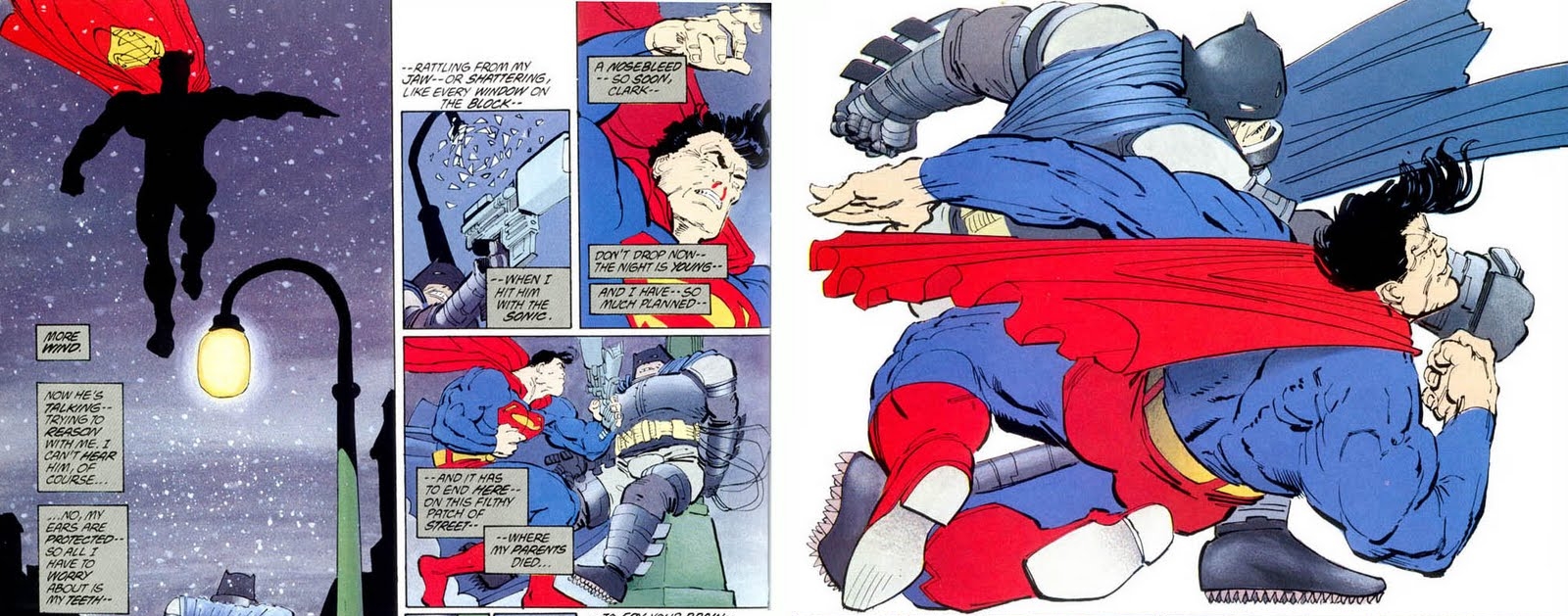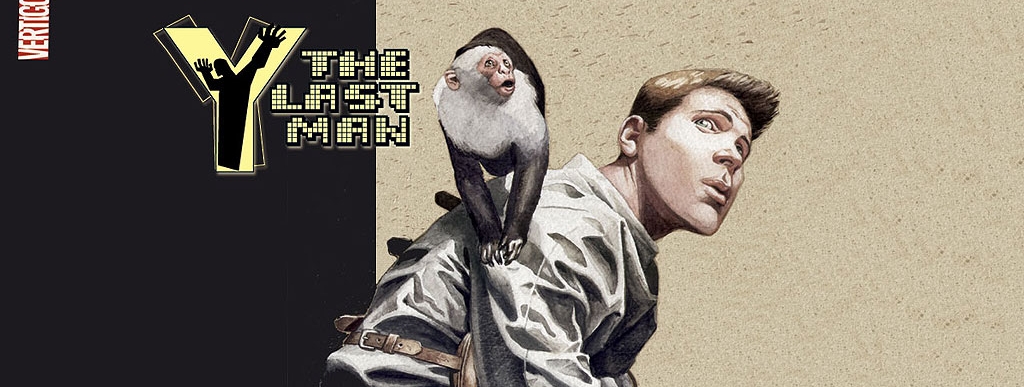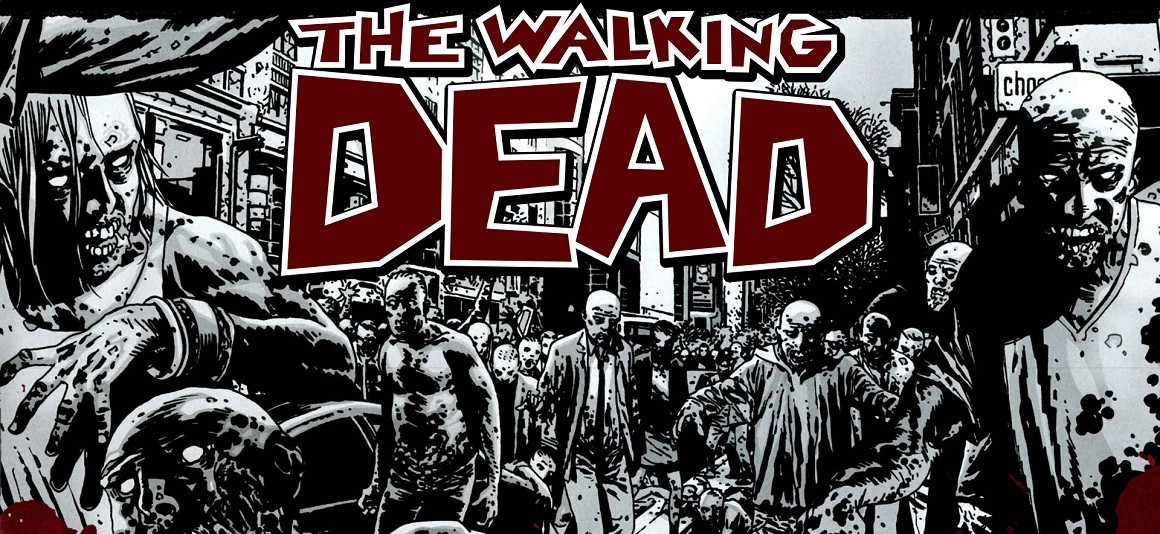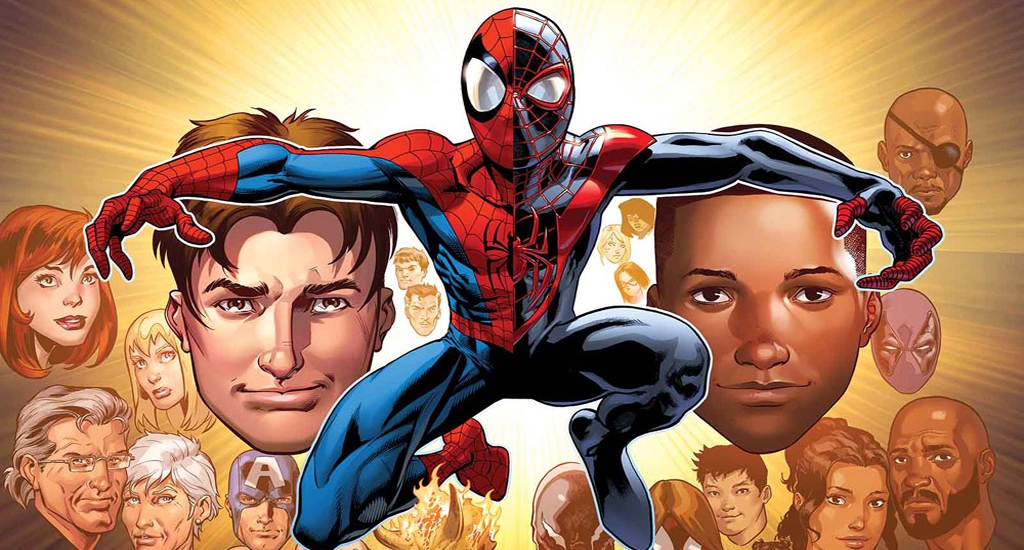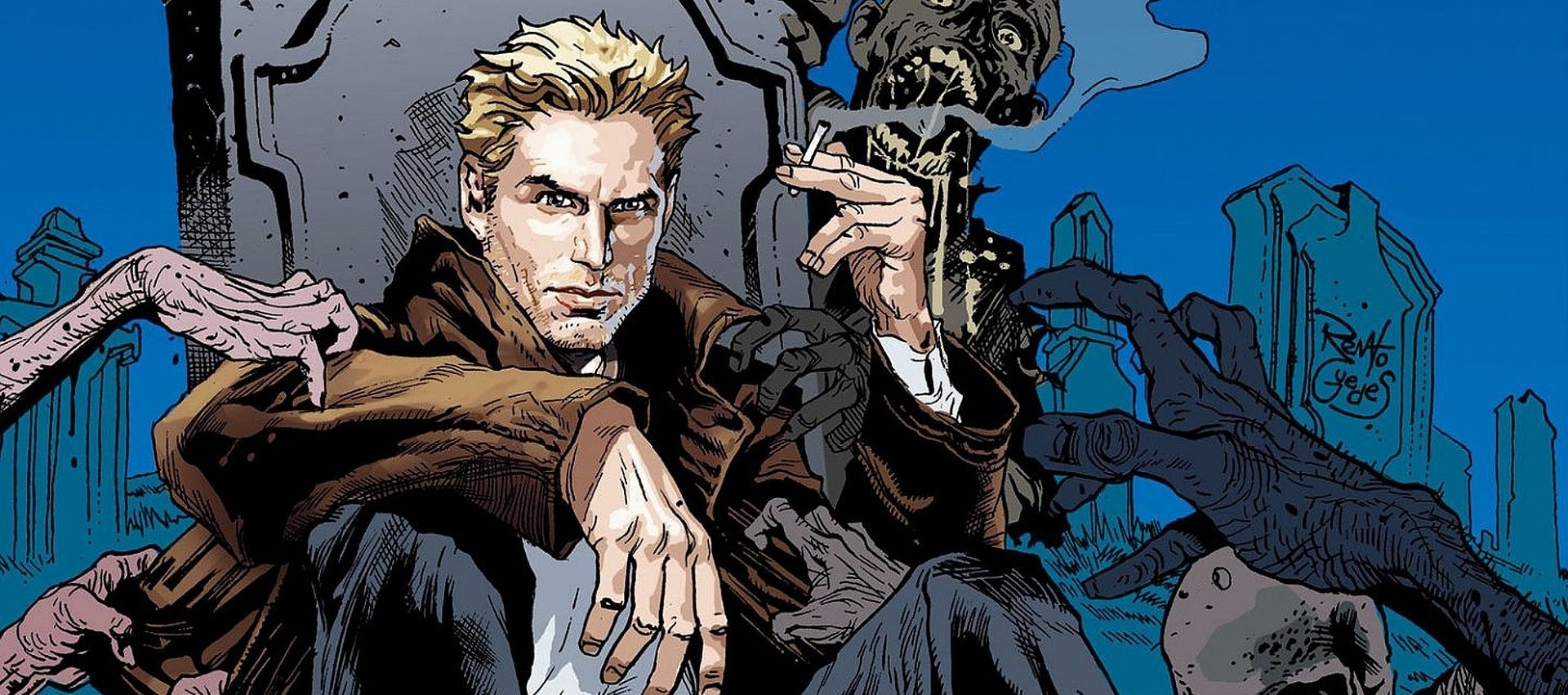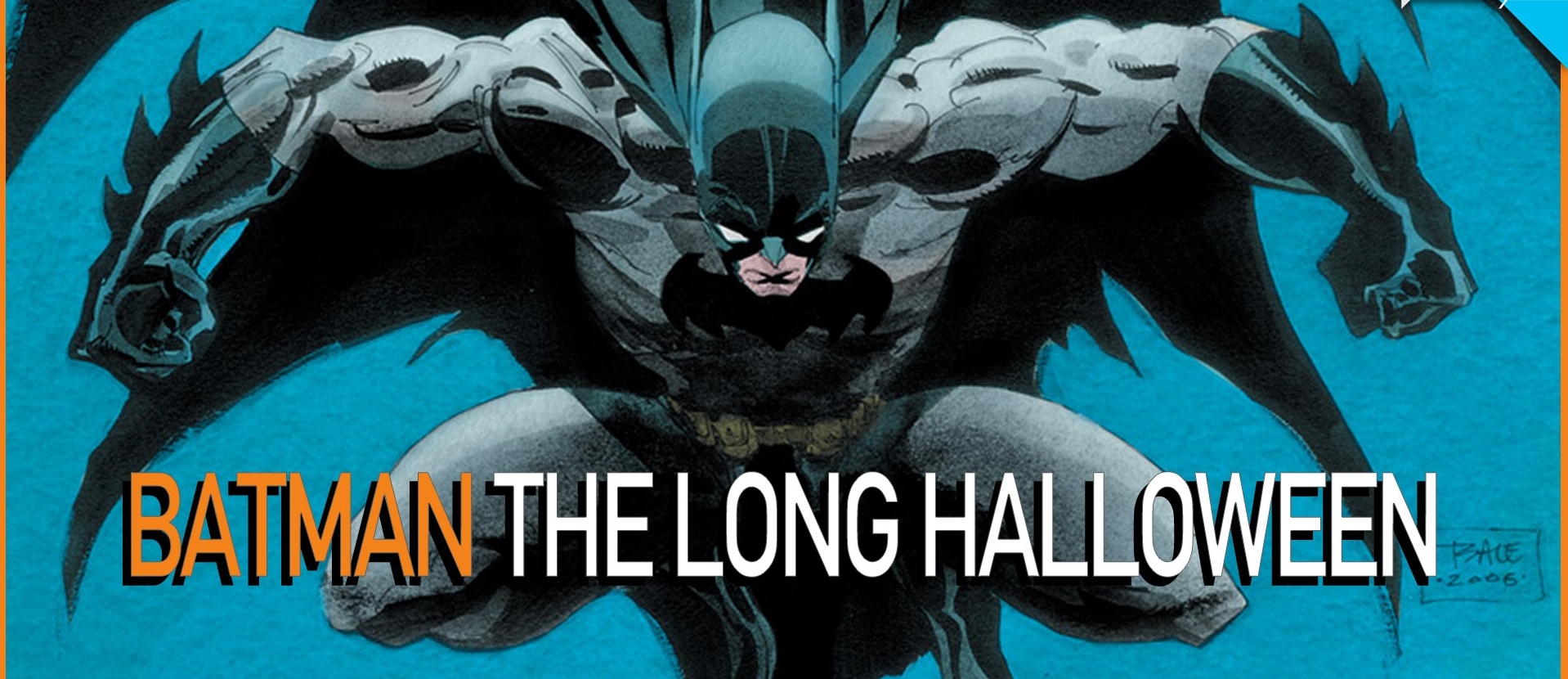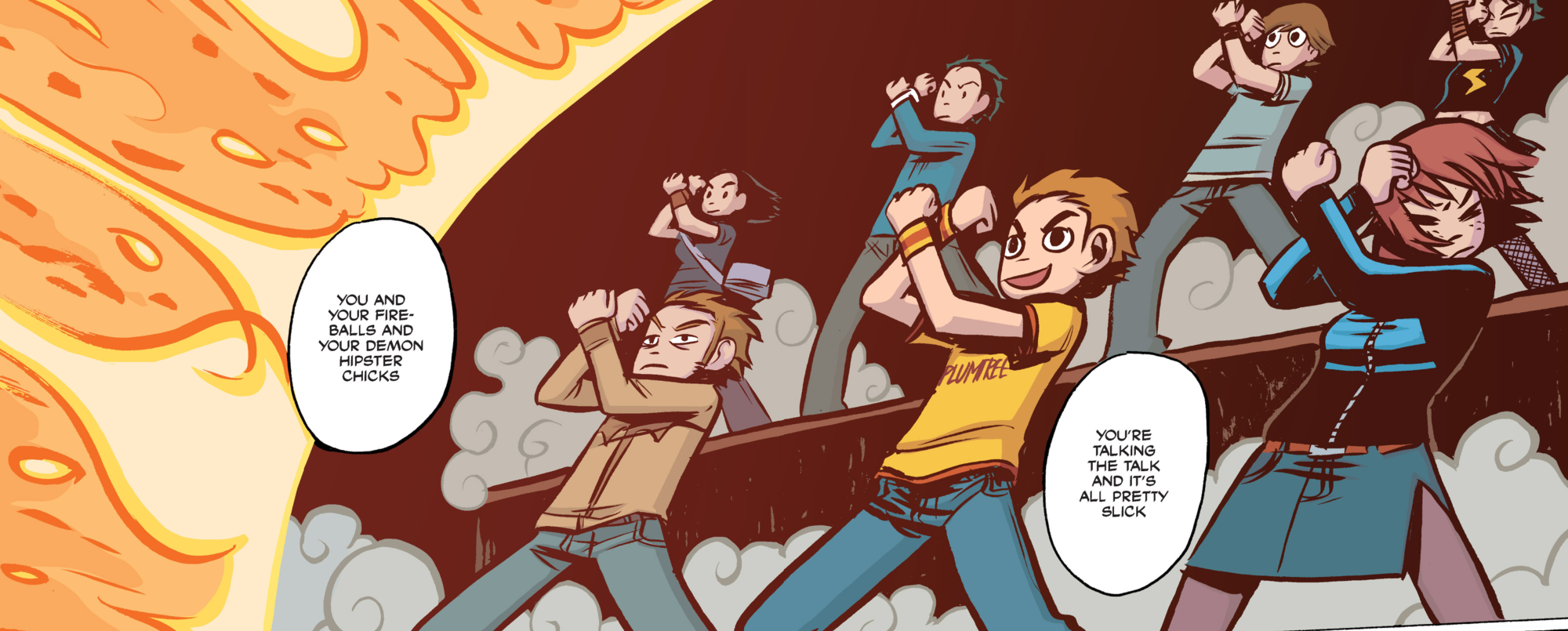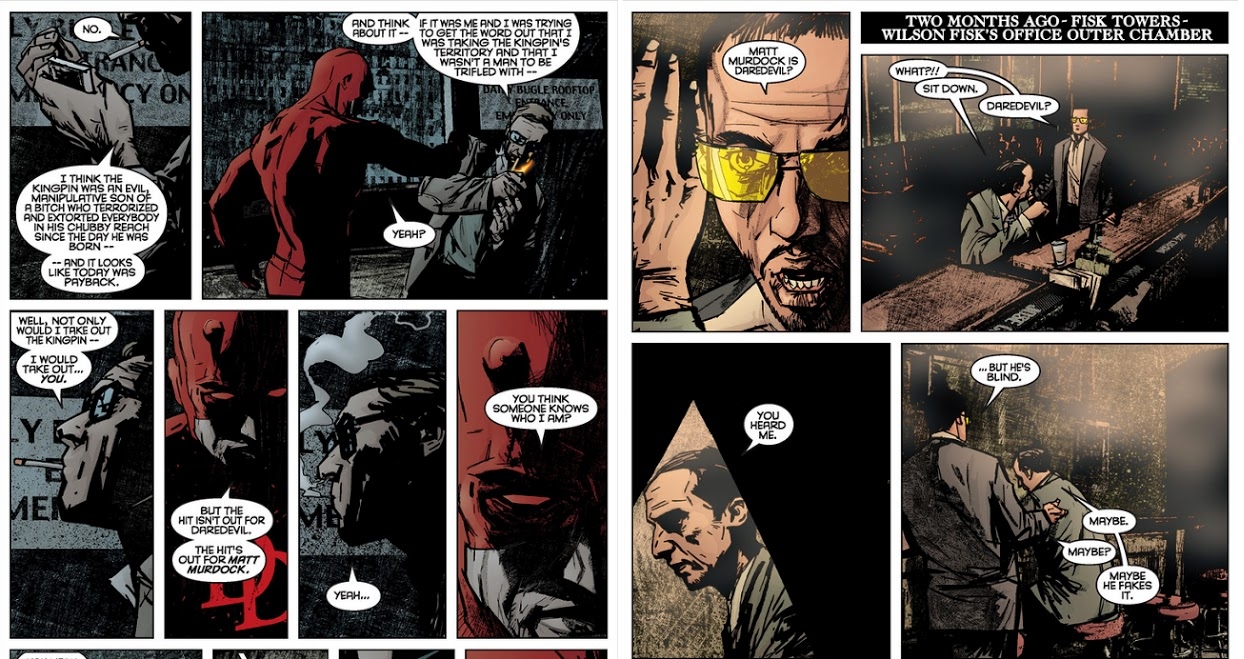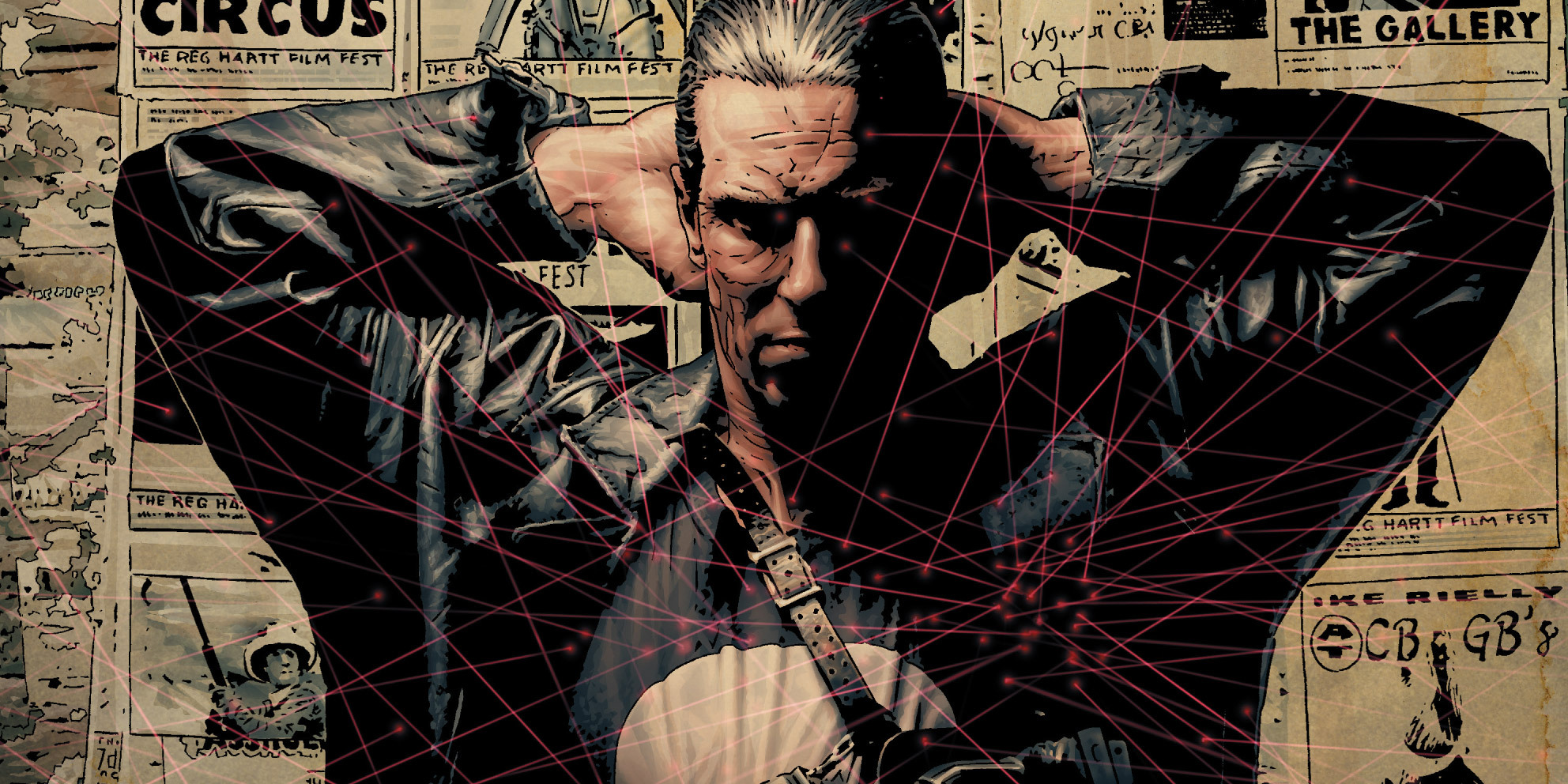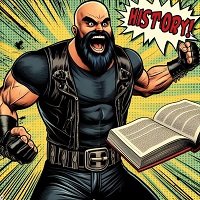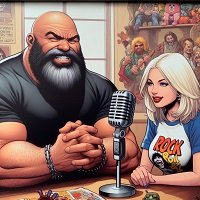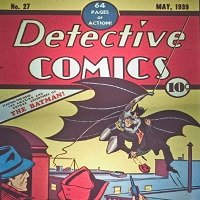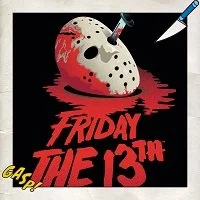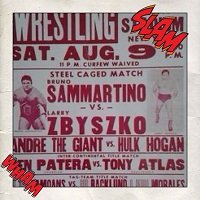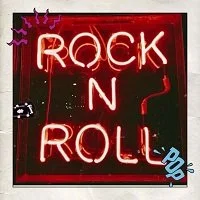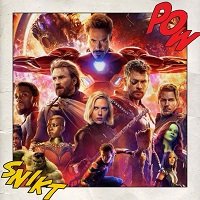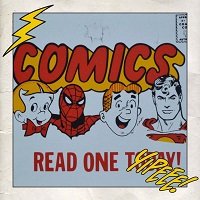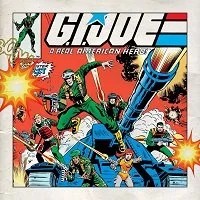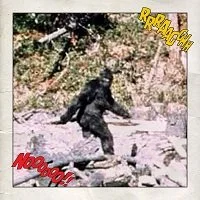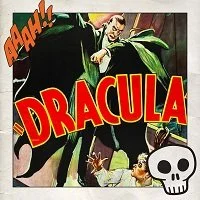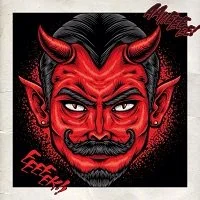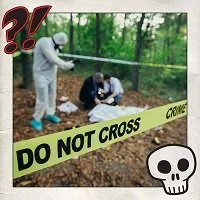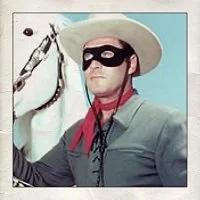Return to WhenItWasCool.com Home Page
100 Greatest Comic Books - Comic Book Runs - Single Issue Comics & Graphic Novels of All Time.
By: Karl Stern
This is the latest of our "The 100" “Best of…” lists and it takes a look at one of my favorite lifelong hobbies- comics and comic book collecting. I learned to read from comic books. Before I even entered school I was well ahead of the "See Jane run" kids and it was because of comic books. I have lived a happier and more imaginative life because of comics which has brought me countless hours of joy.
In this list of the 100 Greatest Comics, Comic Book Runs, Single Issue Comics, and Graphic Novels (or major storyline arcs) I explore some of the most highly regarded issues, series, and collected editions in comic book history.
I have used multiple website and print media "Top Comics" and "Best Comics" lists to help compile the When It Was Cool Top 100 Comics of All Time and have averaged them together, giving more credence to more established and expert writers, sites, and publications. I have included a list of sources at the end of this article. I have also received numerous suggestions from the visitors of When It Was Cool and listeners to the When It Was Cool Podcast.
The Process...
I referenced numerous other popular "Top 100 Greatest Comics" or "Top 100 Greatest Graphic Novels" or "Best Comics Ever" lists and averaged their rankings. I then added points to my own personal picks and those suggested by When It Was Cool podcast listeners as well. Sales numbers didn't factor that strongly into the best comics list because modern era comics sell significantly fewer issues than older comics and over the last twenty years publishers have pushed gimmick sales on retailers to artificially inflate numbers to obtain gimmick comic book covers and such.
After numerous comic book lists and rankings were averaged together, here are the When It Was Cool 100 Greatest Comic Books of All Time.
If you enjoy this article: You might also enjoy the 100 Favorite Comic Book Issues of When It Was Cool!
1) Batman - The Dark Knight Returns (DC Comics)
Batman The Dark Knight Returns made almost every single "Comic Book Best of" list. Consistently, it was in the top five of every comic list out there and often at number one. Batman: The Dark Knight Returns was a 1986 four-issue miniseries by Frank Miller, illustrated also by Miller and Klaus Janson, and published by DC Comics. When the comic series was collected into a single edition later that year, the story title was applied to the entire series. The Dark Knight Returns tells the story of Bruce Wayne who, at 55 years old, returns from retirement to fight crime and faces opposition from the Gotham City police and the U.S. government. The story introduces Carrie Kelley as the new Robin and culminates with a confrontation against Superman. I must admit I am not as big a fan of Batman The Dark Knight Returns as many are as I found the story too dark and grim and the art not really to my liking, but that is subjectivity on my part and the vast critical acclaim for this story can not be denied. You might also like our review of Batman Issue 1 from 1940 and our reviews of the first live action Batman movies from the 1940s.
2) The Sandman (DC Comics / Vertigo)
Dark fantasy, horror, surrealism- all these styles come together in the critically acclaimed The Sandman comic book series from Vertigo Comics (a sub-imprint of DC Comics). The Sandman was written by Neil Gaiman. Its artists included Sam Kieth, Mike Dringenberg, Jill Thompson, Shawn McManus, Marc Hempel, and Michael Zulli, with lettering by Todd Klein and covers by Dave McKean. Beginning with issue 47, this comic book was placed under the Vertigo imprint. The Sandman tells the story of Dream of the Endless, who rules over the world of dreams. The comic series ran for 75 issues from January 1989 to March 1996.
3) Watchmen (DC Comics)
No surprise here. Watchmen is either at or near the top of every single "Best of comics" list. It is the best selling graphic novel in comic book history and spun off a major motion picture and, later, a television series. Watchmen was a graphic novel published by DC Comics in 1986 and 1987. The series was created by a British collaboration consisting of writer Alan Moore, artist Dave Gibbons, and colorist John Higgins. Watchmen originated from a story proposal Alan Moore submitted to DC comics featuring superhero characters that the company had acquired from Charlton Comics. DC Comics managing editor Dick Giordano convinced Moore to create original characters instead. You will see Alan Moore several more times on this list.
4) Kingdom Come (DC Comics)
This was my personal pick for number one as I enjoyed DC Comic's Kingdom Come far more than Dark Knight Returns, The Sandman, or Watchmen. Kingdom Come was a four-issue mini-series published in 1996 by DC Comics under their Elseworlds imprint. It was written by Mark Waid and Alex Ross and painted by Alex Ross. The Kingdom Come story is set in a future that deals with a growing conflict between the visibly out-of-touch "traditional" superheroes like Superman and Wonder Woman, and a growing population of largely amoral and irresponsible new vigilantes, often the offspring of the traditional heroes. Between these two groups is Batman, who attempts to contain the escalating disaster, foil the plots of Lex Luthor, and prevent a world-ending superhuman war. Captain Marvel and Superman also play major roles in this epic comic book series.
5) Fables (Vertigo)
Fables was a comic book series created by Bill Willingham and published by DC Comics' Vertigo imprint. Willingham served as sole writer for its entirety, with Mark Buckingham penciling more than 110 issues. Fables was launched in July 2002, and concluded in July 2015. Fables features various characters from fairy tales and folklore who refer to themselves as "Fables" and who formed a community centuries ago within New York City known as Fabletown. It is set in modern-day and follows several of Fabletown's characters, such as Sheriff Bigby Wolf, Deputy Mayor Snow White, her sister Rose Red, Prince Charming, and Boy Blue, as they deal with troublesome Fables and try to solve conflicts in both Fabletown and "the Farm", a hidden town in upstate New York for Fables unable to blend in with human society. An imaginative comic book series based on classic old properties.
6) Y the Last Man (Vertigo)
Y: The Last Man was a post-apocalyptic comic book series by Brian K. Vaughan and Pia Guerra published by Vertigo beginning in 2002. The series tells the story of the only man who survives the apparent simultaneous death of all other male mammals on Earth except the man's pet monkey. Y the Last Man was published in sixty issues by Vertigo comics and collected in a series of ten paperback graphic novels and received huge critical acclaim including three Eisner Awards.
7) Preacher (Vertigo)
No surprise here as Preacher has been a critical favorite since it's publication. I personally have never liked the Preacher comic book series and have tried several times to read it. However, it ranked highly on virtually every "Best of Comics" list used to compile these rankings. Preacher is a comic book series published by Vertigo, an imprint of DC Comics. The series was created by writer Garth Ennis and artist Steve Dillon with painted covers by Glenn Fabry. Preacher lasted 75 issues in total - 66 regular, monthly issues, five one-shot specials and a four-issue Preacher: Saint of Killers limited series. The final monthly issue, number 66, was published in October 2000. Preacher tells the story of Jesse Custer, a preacher in the small Texas town of Annville. Custer is accidentally possessed by a supernatural creature named Genesis. The incident flattens Custer's church and kills his entire congregation.
8) All Star Superman (DC Comics)
A fan and critic favorite. When I read through All Star Superman a few years ago I remember thinking the comic book series was pretty great but I didn't think it would have the enduring legacy that it has turned out to have. It performed very highly on most of the lists referenced for this study. All-Star Superman was a twelve-issue comic book series that was published by DC Comics. All-Star Superman ran from November 2005 to October 2008. The series was written by Grant Morrison, drawn by Frank Quitely, and digitally inked by Jamie Grant. Grant Morrison stated that he wasn't interested in "re-doing origin stories or unpacking classic narratives" but instead wanted to do "a total update, re-haul and refit". However, rather than just creating a "fresh and relevant" update for new readers, Morrison wanted to write a "collection of ‘timeless’ Superman issues". Mission accomplished. You might also like our reviews of the 1940's-50s Superman movie serials.
9) Saga of the Swamp Thing (Alan Moore era) (DC Comics)
Another favorite of comic book critics is Alan Moore. In 1982 DC Comics revived Swamp Thing attempting to capitalize on the summer 1982 release of the Wes Craven Swamp Thing movie. The new series called Saga of the Swamp Thing featured an adaptation of the Craven movie in its first annual. Now written by Martin Pasko, the book loosely picked up after Swamp Thing's appearance in Challengers of the Unknown, with the character wandering around the swamps of Louisiana seen as an urban legend and feared by locals. When Pasko had to give up work on the title due to increasing television commitments, editor Len Wein assigned the title to British writer Alan Moore. Moore was given free rein to revamp the title and the character as he saw fit and reconfigured Swamp Thing's origin to make him a true monster as opposed to a human transformed into a monster. You might enjoy our Patreon podcast special reviewing the Swamp Thing television series - here.
10) Marvels (Marvel Comics)
A truly beautiful comic book with unforgettable art, Marvels was a four-issue limited series comic book written by Kurt Busiek, painted by Alex Ross and edited by Marcus McLaurin. It was published by Marvel Comics in 1994. Marvels is set in the 1939 to 1974 time period and examines the Marvel Universe, the collective setting of most of Marvel's superhero series, from the perspective of news photographer Phil Sheldon. Marvels was a critical success winning multiple awards. It seems to me that adding Alex Ross to anything just makes it better.
11) Maus (Pantheon)
Maus was a graphic novel that transcended the world of comics into true literally accepted high art. Cartoonist Art Spiegelman serialized the story from 1980 to 1991 and it depicts Spiegelman interviewing his father about his experiences as a Polish Jew and Holocaust survivor. Maus visualized Jews as mice and other Germans and Poles as cats and pigs. Critics have alternately classified Maus as memoir, biography, history, fiction, autobiography, graphic novel, and a mix of genres. It became the first graphic novel to win a Pulitzer Prize in 1992. You read that right. A comic book won the Pulitzer Prize.
12) Fantastic Four (Lee & Kirby 1-102) (Marvel Comics)
There were so many of the first 102 issues of Marvel Comics Fantastic Four which could have placed on this list that the decision was made to induct the entire 102 issue run by Stan Lee and Jack Kirby at number 12. This run gave the world so many legendary comic book moments from the debut of Dr. Doom in issue five to the story of Galactus and the Silver Surfer. The Fantastic Four launched the modern age of Marvel Comics and Jack Kirby's art and Stan Lee's story ideas make this run one of the most iconic in all of literature. Check out our Marvel Universe in Order Podcast where we cover the early issues of Fantastic Four.
13) Amazing Spider-Man (Lee & Ditko - Amazing Fantasy 15- Amazing Spider-Man 100) (Marvel Comics)
Another iconic Silver Age Marvel Comics run, this one by Stan Lee and Steve Ditko, which introduced the world to the Amazing Spider-Man in the pages of Amazing Fantasy 15 and then ran in the pages of Amazing Spider-Man through issue 100. The art by Ditko is striking and the design of the Spider-Man costume is one of the most recognizable in comics. The thing that seems to have really struck a chord with readers, however, is the story of the bullied intellectual Peter Parker who finds himself with amazing powers but heavy responsibilities. The Stan Lee and Steve Ditko run on Amazing Spider-Man has stood the test of time as one of the all time great runs in comics.
14) Uncanny X-Men (Chris Claremont 94-279) (Marvel Comics)
Chris Claremont's run on Uncanny X-Men stretched from 1975 to 1991 and is often cited as one of the all time greatest writing runs in comic book history. It was during this time that the X-Men comics hit their peak in popularity based around Claremont's deeply dramatic storytelling and strong character portrayals, especially strong female characters. During his seventeen years as X-Men writer, Claremont wrote or co-wrote many classic X-Men stories, such as "The Dark Phoenix Saga" and "Days of Future Past" both of which would have independently made this list had we not simply included the entire run as one entry. Likewise, X-Men: God Loves, Man Kills was also during the Chris Claremont era but since it was a stand-alone story it is included separately on this list.
15) Bone (Cartoon Books / Image)
Bone was an independently published comic book series written and illustrated by Jeff Smith from 1991 to 2004. Bone was a black-and-white comic series inspired by animated cartoons and comic strips Bone received numerous awards, among them ten Eisner Awards and eleven Harvey Awards. Bone centers on the three Bone cousins: Phoncible P. "Phoney" Bone, Smiley Bone, and Fone Bone who have been run out of their hometown of Boneville after Phoney's campaign for mayor went awry.
16) Batman - Year One (DC Comics)
Our second Batman entry on the list, Batman: Year One was a comic book story arc published by DC Comics, and tells of Batman's first year as a crime-fighter. It was written by Frank Miller, illustrated by David Mazzucchelli, colored by Richmond Lewis, and lettered by Todd Klein. Batman: Year One originally appeared in issues #404–407 of Batman in 1987. It also tells the story of the life of officer James "Jim" Gordon.
17) Captain America (Ed Brubaker 1-50) (Marvel Comics)
This is one of my personal favorite stories in comic book history. I remember reading it through for the very first time and could not wait to get to the next issue. Known officially, I suppose, as Captain America (Vol. 5) it was published for four years from January 2005 to July 2009 by Marvel Comics. After its fiftieth issue (July 2009), the series was renumbered to match the numbering of all the volumes of the title (454, 13, 50, 32, and 50), and volume 1 resumed publication with issue 600 with Ed Brubaker remaining as writer. Captain America Vol. 5 was best known for reviving Captain America's World War II partner Bucky Barnes as the Winter Soldier, the presumed death of Steve Rogers, and Bucky taking over the identity of Captain America.
18) Astro City (Vol. 1) (Image)
Kurt Busiek's Astro City is a critically acclaimed superhero anthology comic book series centered on a fictional American city named Astro City. Created by Kurt Busiek, the comic series is mostly illustrated by Brent Anderson, with character designs and painted covers by Alex Ross. Astro City debuted in August 1995 and was published by Image Comics, eventually moving to Homage Comics. The first Astro City series was published from 1995–1998. Astro City explores how ordinary people and the heroes and villains react and interact in the world of Astro City.
19) Batman The Killing Joke (DC Comics)
Many consider Batman - The Killing Joke as the definitive Joker story. Batman: The Killing Joke was a 1988 DC Comics one-shot graphic novel written by Alan Moore and illustrated by Brian Bolland. The Killing Joke provides an origin story for the Joker and depicts the Joker attempting to drive Jim Gordon insane and Batman's attempt to stop him. The story impacted the mainstream Batman continuity due to the shooting and paralysis of Barbara Gordon (a.k.a. Batgirl). This graphic novel trended highly among When It Was Cool readers.
20) The Walking Dead (Image Comics)
The Walking Dead has transcended comic books into a pop culture phenomenon. The popular television series was spawned by The Walking Dead, an ongoing black-and-white comic book series created by writer Robert Kirkman and artist Tony Moore. It is, in part, the story of Rick Grimes, a deputy who is shot in the line of duty and awakens from a coma in a zombie apocalypse. Grimes finds his wife and son, and others who form a group and later a community. First released in 2003 by Image Comics. The Walking Dead received the 2007 and 2010 Eisner Award for Best Continuing Comic Book Series.
21) Daredevil (Frank Miller era) (Marvel Comics)
Like a few of the comic books mentioned previously, there are several individual issues and arcs within the Frank Miller run on Marvel Comics Daredevil which could have independently have made this list. Frank Miller made his debut on Daredevil with Daredevil 158 (May 1979). With issue 168 (Jan. 1981), Frank Miller took over full duties as writer and penciller. Issue 168 also saw the first appearance of the Elektra, a character who would become a popular fan favorite. Frank Miller also added a martial arts aspect to Daredevil's fighting skills and introduced new characters like Stick. Frank Miller's stint on Daredevil was characterized by dark stories. In Daredevil 181 (April 1982) Miller had the assassin Bullseye kill Elektra. Miller ended his Daredevil run with issue 191 (Feb. 1983).
22) Fantastic Four (Jonathan Hickman era) (Marvel Comics)
From 2009 to 2012, Jonathan Hickman wrote some of the most imaginative and interesting Fantastic Four comic book stories since the early days of the series. After a number of years of the Fantastic Four being largely stagnant, Hickman revived the comic book by placing the family in a more imaginative "explorer" role than in previous years. This took the first family of Marvel Comics into a more interesting direction than the usual super-hero fists fights with rehashed and retooled villains of the month. The Fantastic Four now explored the greater reaches of the Multiverse which gave rise to some of the most fantastic stories written in ages. One of my personal favorite picks.
23) Ultimate Spider-Man (1-111 Brian Michael Bendis era) (Marvel Comics - Ultimate Imprint)
I am not usually a big fan of origin stories being retold for the millionth time but Brian Michael Bendis hit a home run with the Marvel Ultimate Universe Ultimate Spider-Man comic book series. Ultimate Spider-Man was published by Marvel Comics from 2000 to 2009 and existed in a Universe alongside other Ultimate Marvel titles including Ultimate X-Men, Ultimate Fantastic Four, and The Ultimates. Ultimate Spider-Man first launched in 2000 with veteran Spider-Man artist Mark Bagley and writer Brian Michael Bendis, who expanded the original 11-page origin story into a 180-page, seven issue story arc. This duo continued to collaborate until issue #111, when Mark Bagley left the book and was replaced by Stuart Immonen.
24) New Teen Titans (Wolfman & Perez era) (DC Comics)
Sometimes a writer and an artist combination work in perfect synchronicity. This was the case with Marv Wolfman and George Perez and their run on New Teen Titans. The New Teen Titans #1 (November 1980) with writer Marv Wolfman and artist George Perez, re-introduced Beast Boy as Changeling and introduced Cyborg, Starfire, and Raven. The team's adversaries included fan favorite Deathstroke the Terminator. One of the most popular New Teen Titans storylines was 1984's "The Judas Contract", which took place in Tales of the Teen Titans 42–44 and Teen Titans Annual #3. "The Judas Contract" won the Comics Buyer's Guide Fan Award for "Favorite Comic Book Story" of 1984.
25) Miracleman / Marvelman (Multiple Publishers)
Originally a British stand-in for Captain Marvel (Shazam), Marvelman gained critical acclaim by way of a 1982 dark, post-modern reboot by Alan Moore. I must confess that I am not a fan of Marvelman nor the legally forced renamed Miracleman. Having read most all of those comic books myself I thought they left a lot to be desired and didn't hold up very well over time. Still, they have garnered enough critical acclaim to be on most "best of comic book" lists. In his run of Marvelman stories, Alan Moore touches on dark themes including the superhero as a source of terror, a comic book trope which has been frequently repeated in the modern era.
26) Hellblazer (Vertigo)
The longest running comic of DC Comics Vertigo imprint, Hellblazer was a horror comic book series which began print in March 1993. Its central character is John Constantine, another Alan Moore character, who first appeared as a supporting character in The Saga of the Swamp Thing #37 (June 1985). In 2013, the series ended with issue 300. Known for its political and social commentary Hellblazer has spawned a movie adaptation and television series.
27) Planetary (Wildstorm)
Planetary is a comic book series created by writer Warren Ellis and artist John Cassaday and published by the Wildstorm imprint of DC Comics. The series ran for 27 issues from April 1999 to October 2009. I have never personally read this series but it was consistently highly rated in the majority of critical lists used to compile this ranking. "Archaeologists of the Impossible", Planetary is an organization searching for the world's secret history.
28) Saga (Image)
One of the stranger tales in our countdown of the best comic books of all time is the highly acclaimed Saga series from Image Comics. Saga is an epic space opera and fantasy comic series written by Brian K. Vaughan and illustrated by Fiona Staples. It follows a husband and wife, Alana and Marko, from warring extraterrestrial races, fleeing authorities from both sides of a galactic war as they struggle to care for their daughter, Hazel, who is born in the beginning of the series and who occasionally narrates the series as an unseen adult.
29) Batman - The Long Halloween (DC Comics)
A continuation of the previously mentioned Batman - Year One, Batman: The Long Halloween is a 13-issue limited comic series written by Jeph Loeb with art by Tim Sale. It was published by DC Comics in 1996 and 1997. Taking place during Batman's early days of crime fighting, The Long Halloween tells the story of a killer named Holiday, who murders people on holidays. Batman races against the calendar to discover who Holiday is before he claims his next victim. The story also ties into the events that transform Harvey Dent into Batman's enemy, Two-Face. The Scarecrow, the Joker, Mad Hatter, Poison Ivy, and the Riddler also make appearances.
30) Scott Pilgrim (Oni Press)
Another comic book and graphic novel series adapted into a movie, Scott Pilgrim is a series of graphic stories by Bryan Lee O'Malley. The series is about Canadian Scott Pilgrim, a slacker and part-time musician who lives in Toronto, Ontario and plays bass guitar in a band. He falls in love with an American delivery girl Ramona Flowers, but must defeat her seven evil exes in order to date her. Released between August 2004 and July 2010, by Portland-based independent comic book publisher Oni Press. It was later republished by Fourth Estate, an imprint of Harper-Collins.
31) Jimmy Corrigan- The Smartest Kid on Earth (Pantheon)
Jimmy Corrigan: The Smartest Kid on Earth is a graphic novel by cartoonist Chris Ware. Pantheon Books released the book in 2000 following its serialization in the newspaper Newcity and Ware's Acme Novelty Library series. Corrigan is a meek thirty-six-year-old man who meets his father for the first time in the fictional town of Waukosha, Michigan. The series deals with such concepts as social and family awkwardness. The series has received numerous critical awards.
32) Transmetropolitan (DC Comics)
I'll admit that Transmetropolitan is a comic book series not in my wheelhouse. I have read the series before but did not identify with it in any way. Still, the series had gained considerable critical acclaim. Transmetropolitan is a cyberpunk trans-humanist comic book series written by Warren Ellis and co-created and designed by Darick Robertson and published by DC Comics in 1997-2002. Transmetropolitan chronicles the battles of Spider Jerusalem, infamous renegade gonzo journalist of the future, an homage to gonzo journalism founder Hunter S. Thompson.
33) Legion of Superheroes (Paul Levitz era) (DC Comics)
Paul Levitz returned to write Legion of Superheroes with issue 284 in the early 1980s. The title received new popularity following "The Great Darkness Saga", which ran from issue 287-294; and Annual #3, featuring a full assault on the United Planets by Darkseid. The Legion celebrated issue 300 (June 1983) by revisiting the "Adult Legion" through a series of parallel worlds. A new Legion of Super-Heroes comic was launched in August 1984. The existing Legion series, renamed Tales of the Legion of Super-Heroes with issue 314, continued running new material for a year, then began reprinting stories from the new Legion of Super-Heroes comic book series.
34) Love & Rockets (Fantagraphics)
Love and Rockets was an iconic alternative comic book by the Hernandez brothers: Gilbert, Jaime, and Mario. It was one of the cornerstones of the alternative comics movement of the 1980s. The Hernandez brothers wrote stories in the series independently of each other with Gilbert and Jaime producing the majority of the material which focused on a particular cast of characters and settings including a fictional Central American village of Palomar. The Locas stories of Jaime centered on a social group in Los Angeles, particularly Latin-American friends and sometimes-lovers Maggie and Hopey. Love & Rockets is really not at all my type of comic book or series but it is highly critically acclaimed and made virtually every ranking I used for this list.
35) Daredevil (Bendis 26-81 2001) (Marvel Comics)
This Marvel comic book run is considered among the best work of Brian Michael Bendis. With heavy crime-drama themes, this critically acclaimed series dealt with such story elements as a gangster trying to take over the Kingpin’s racket, Daredevil’s secret identity being revealed, Milla Donovan, a blind woman who became Daredevil's wife, The Owl attempted to take over the Kingpin’s racket, and the return of The Kingpin.
36) Animal Man (Grant Morrison era) (DC Comics)
Part of the British Invasion of comics, Grant Morrison developed several long-running plotlines in the pages of Animal Man to tremendous critical acclaim. Grant Morrison made Animal Man an every-man type figure. The series championed vegetarianism and animal rights. Grant Morrison worked on the book from 1988-1990.
37) The Mighty Thor (Walt Simonson era) (Marvel Comics)
Walt Simonson took over both writing and art on The Mighty Thor with issue 337 (Nov. 1983). Simonson's stories placed a greater emphasis on Thor's mythological origins and his run as writer-artist lasted until issue 367 (May 1986), although he continued to write and occasionally draw the book until issue 382 (Aug. 1987). Simonson also introduced the character Beta Ray Bill.
38) Wolverine 1-4 (Vol. 1 1982) (Marvel Comics)
The first Wolverine limited series was written by Chris Claremont with pencils by Frank Miller, inks by Joe Rubinstein, letters by Tom Orzechowski, and colors by Glynis Wein. Marvel Comics published Wolverine volume one from September to December 1982. The story covers the events leading up to Wolverine's engagement to Mariko Yashida.
39) The Ultimates (Vol. 1) (Marvel Comics - Ultimate Imprint)
The Ultimates volume one was written by Mark Millar and illustrated by Bryan Hitch and was published in limited series format for thirteen issues, with production delays, from March 2002 until April 2004. As part of the alternate Marvel comics continuity Ultimates line, The Ultimates was that universe's version of The Avengers with a new take on each of the main characters including Captain America, Thor, and The Hulk.
40) League of Extraordinary Gentlemen (America's Best Imprint)
Another Alan Moore entry on the list. The League of Extraordinary Gentlemen was co-created by writer Alan Moore and artist Kevin O'Neill in 1999. The series spans two six-issue limited series, Volume I, Volume II, and an original graphic novel Black Dossier from the America's Best Comics imprint of DC Comics. According to Alan Moore, the concept behind the series was initially a "Justice League of Victorian England" but he quickly developed it as an opportunity to merge elements from many works of fiction into one world including Captain Nemo, Allan Quatermain, Dr. Jekyll, The Invisible Man, Fu Manchu, Professor Moriarty, and Mina Murray.
41) Hellboy - Seed of Destruction (Dark Horse)
Hellboy: Seed of Destruction was the first Hellboy comic book mini-series published by Dark Horse Comics. It was conceived and illustrated by Mike Mignola. Hellboy - Seed of Destruction opens in 1944 with a report from a U.S Army official named George Whitman, who has been ordered to lead a team of commandos to the village of East Bromwich in the English Midlands. The story essentially tells of Hellboy's "birth".
42) 100 Bullets (Vertigo)
100 Bullets is a concept series running for 100 issues with the core concept based on the question of people willing to act on the desire of violent revenge if given the means, opportunity, and a reasonable chance to succeed. Many issues involve the mysterious Agent Graves approaching someone who has been a victim of a terrible wrong. Graves gives them the opportunity to take revenge by providing a handgun, 100 bullets, and documentation about the primary target responsible for their woes. He informs the candidate the bullets are completely untraceable by any law enforcement investigation, and as soon as they are found at any crime scene, investigations will immediately cease. 100 Bullets was met with great critical acclaim and performed well on most of the "Best of Comics" lists referenced for our article.
43) Batman Arkham Asylum (DC Comics)
Both Grant Morrison and Batman are becoming regulars on this top 100 list. Batman- Arkham Asylum was the first Batman story to be written by Grant Morrison before becoming a regular writer on Batman titles. Morrison conceived the story to be his own different approach to the character, using heavy symbolical references. The story follows Batman, who is called upon to quell a riot taking place in Arkham Asylum in Gotham City. Batman confronts many of his rogues gallery, such as the Joker, Two-Face, and Killer Croc. As Batman ventures deeper, he discovers the origin of how the asylum was established, the history of its builder Amadeus Arkham, and the supernatural and psychological mystery that have been haunting the area.
44) Spider-Man Death of Gwen Stacy (Marvel Comics)
Spider-Man "The Death of Gwen Stacy" or the actually titled "The Night Gwen Stacy Died" is a story arc of Marvel Comics The Amazing Spider-Man issues 121 & 122 (June & July 1973), that became a monumental event in the life of Spider-Man. The two-issue story was written by Gerry Conway, with pencil art by Gil Kane and inking by John Romita, Sr. and Tony Mortellaro, and features Spider-Man's fight against his nemesis, the Green Goblin. The Green Goblin abducts Spider-Man's girlfriend Gwen Stacy, and she is killed during the battle.
45) X-Men - God Loves, Man Kills (Marvel Comics)
God Loves, Man Kills was initially conceived as a non-canon X-Men story. The original first script called for the death of Magneto. Magneto's death was dropped once Neil Adams left the project and the script rewritten into what became the published version. Published in 1982, for years the canonical status of God Loves, Man Kills existed in a state of flux. It was not officially considered canon until 2003, when the second X-Men film (which borrowed heavily from the graphic novel) was released in theaters and a sequel series God Loves Man Kills II was published in X-Treme X-Men #25-30. The issue is placed between Uncanny X-Men issues 167 and 168.
46) Astonishing X-Men (2004) (Marvel Comics)
Astonishing X-Men series was written by Joss Whedon and illustrated by John Cassaday. It is a continuation of Grant Morrison's New X-Men title and features a similar line-up of characters, including Cyclops and Emma Frost (as co-team leaders), Beast, Kitty Pryde, Colossus, Lockheed, and Wolverine. Astonishing X-Men introduced a number of original characters into the Marvel Universe including Kavita Rao, Special Agent Brand, S.W.O.R.D., Hisako Ichiki, Ord of the Breakworld and Blindfold.
47) Punisher MAX (Garth Ennis) (Marvel Comics)
While dark and gritty takes on comic book heroes is one of the most overused writing elements in comics, The Punisher lends itself well to the style and seldom has it been better done than with Punisher MAX by Garth Ennis. Garth Ennis wrote issues 1-60 of the first Punisher MAX imprint book. After that series was canceled after issue #75, the new creative team of writer Jason Aaron and artist Steve Dillon came on board for a series relaunch with a new 1 issue.
48) Crisis on Infinite Earths (DC Comics)
I expected Crisis on Infinite Earths to rank higher due to it's lasting storyline impact but I think the convoluted nature of the story hurt it. For everything Crisis on Infinite Earths did right, it was certainly no jumping on point for new readers. Crisis on Infinite Earths was published by DC Comics from 1985 to 1986, consisting of a 12-issue, limited series several tie-in books. It was produced by DC Comics to simplify it's continuity. Crisis on Infinite Earths was written by Marv Wolfman and illustrated by George Pérez, Mike DeCarlo, Dick Giordano and Jerry Ordway. Crisis on Infinite Earths removed the multiverse concept from the DC Universe and depicted the death of long-standing characters Supergirl and the Barry Allen incarnation of the Flash. Continuity in the DC Universe is divided into pre-Crisis and post-Crisis periods.
49) Amazing Spider-Man - Kraven’s Last Hunt (Marvel Comics)
"Kraven's Last Hunt", also known as "Fearful Symmetry," was a storyline by J.M. DeMatteis and Mike Zeck published in 1987, featuring the final battle between Kraven the Hunter and Spider-Man. The story was originally published in Web of Spider-Man 31-32, The Amazing Spider-Man 293-294, and The Spectacular Spider-Man 131-132.
50) Civil War (2006-2007 Marvel Comics Event) (Marvel Comics)
I was surprised to see Marvel Comic's Civil War limited series and cross-over event from 2006-2007 do as well as it did on the greatest comic book list. I remember the critical opinion at the time being strongly mixed. Civil War consisted of a seven-issue limited series written by Mark Millar and penciled by Steve McNiven, with various other tie-in books published by Marvel at the time. It grabbed some mainstream press due to the presumed death of Captain America in the series. It also spawned a less successful and divisive follow up comic book limited series: Civil War 2.
51) Ghost World (Fantagraphics)
Again, this is not my personal favorite type of comic book, but Ghost World kept popping up time and time again on the "Best of Comics" lists. Ghost World was written by Daniel Clowes. It was serialized in issues 11–18 (June 1993 – March 1997) of Clowes's comic book series Eightball and was published in book form in 1997 by Fantagraphics Books. It was a commercial and critical success. Ghost World follows the day-to-day lives of best friends Enid Coleslaw and Rebecca Doppelmeyer. The two friends wander their unnamed American town, criticizing popular culture and the people they encounter.
52) Nextwave Agents of HATE (Marvel Comics)
Nextwave Agents of HATE is a humorous comic book series by Warren Ellis and Stuart Immonen, published by Marvel from 2006 to 2007. The Nextwave series features a collection of minor Marvel superheroes: Elsa Bloodstone; Monica Rambeau, Tabitha Smith, Aaron Stack, Machine Man; and new character the Captain.
53) Infinity Gauntlet (Marvel Comics Event) (Marvel Comics)
One of my personal favorite Marvel Comics limited-series and crossover events ever. With a strong focus on many of the Marvel cosmic characters like Silver Surfer, Adam Warlock, and Thanos. Infinity Gauntlet told the story of Thanos acquiring the Infinity Gems and gaining god-like powers in a bid to win the affections of Death by killing half of the living universe. The series spawned numerous follow-ups. This series was the inspiration and, loosely, the story told in the blockbuster movie hit Avengers: Infinity War.
54) The Kree-Skrull War (Marvel Comics)
The "Kree-Skrull War" was a story arc written by Roy Thomas, and drawn by Sal Buscema, Neal Adams, and John Buscema. The story was originally published in the Avengers issues 89–97 (June 1971 – March 1972). The story featured a large cast of characters and saw the introduction of the Vision and Scarlet Witch romance.
55) Usagi Yojimbo (Dark Horse Comics, Fantagraphics, others)
Again, Usagi Yojimbo is not necessarily something I would read myself but I certainly understand it's cultural impact and popularity. Usagi Yojimbo was created by Stan Sakai. It is set at the beginning of the Edo period of Japanese history and features anthropomorphic animals replacing humans. The main character is a rabbit Ronin named Miyamoto Usagi based partially on the famous swordsman Miyamoto Musashi.
56) V for Vendetta (DC Comics)
Another Alan Moore entry on the list. V for Vendetta was a British graphic novel written by Alan Moore and illustrated by David Lloyd (with additional art by Tony Weare). Originally published in black and white as an ongoing serial in the short-lived UK anthology Warrior, it morphed into a ten-issue limited series published by DC Comics. V for Vendetta depicts a dystopian and post-apocalyptic future history version of the United Kingdom in the 1990s, preceded by a nuclear war in the 1980s which had devastated most of the rest of the world. Warner Brothers released a film adaptation of V for Vendetta in 2006.
57) Superman - Whatever Happened to the Man of Tomorrow (DC Comics)
Alan Moore strikes yet again. "Whatever Happened to the Man of Tomorrow?" was a 1986 story published by DC Comics written by Alan Moore with long-time Superman editor, Julius Schwartz beginning in Superman issue 423 and ending in Action Comics issue 583, both published in September 1986. The story was drawn by long-time artist Curt Swan and was inked by George Pérez. The story was an imaginary tale which told the final story of the Silver Age Superman and his history, which was being rebooted following the events of Crisis on Infinite Earths, before his modern introduction in the John Byrne series, The Man of Steel.
58) G.I. Joe: A Real American Hero issue 21 (Marvel Comics)
I was pleased to see my own personal favorite comic book single issue make the list. G.I. Joe (Marvel Comics A Real American Hero era) issue 21 is most famously known as the "Silent Issue" or properly "Silent Interlude" and is a single comic book issues devoid of any word balloons telling the story of the ninja Storm Shadow (his first appearance) capturing Scarlet of the G.I. Joe team who is rescued by Snake Eyes with a reveal on the last page of a connection between Storm Shadow and Snake Eyes that had major repercussions throughout G.I. Joe continuity. The issue was written by Larry Hama.
59) Starman (DC Comics)
I missed out on the 1990s Starman series from DC Comics but it was consistently listed on other "best of comics" lists and rankings. Gordon Flagg had this to say about DC Comics Starman, "Of the spate of more-realistic, adult-aimed superhero comics that came in the wake of Alan Moore’s genre-defying Watchmen, Starman is arguably the most ambitious and thoughtful. Jack Knight is the son of a 1940s costumed crime fighter powered by an energy-harnessing cosmic rod. Initially rejecting the family legacy, he reluctantly assumed the mantle after older brother David was killed in battle by their father’s archenemy... Critically lauded in its day but somewhat overlooked by readers, the comic has been collected before in paperback."
60) Superman - Red Son (DC Comics)
For those of you just dying for some Cold War era politics on your "Best of Comics" list we got it covered right here. Superman: Red Son was a three-issue prestige format mini-series published by DC Comics that was released under their Elseworlds imprint in 2003. Author Mark Millar created the comic whose premises was "What if Superman had been raised in the Soviet Union?" It received critical acclaim and was nominated for the 2004 Eisner Award for best limited series.
61) Locke & Key (IDW Publishing)
The plot to Locke & Key is far too complex and complicated to summarize in a paragraph. Locke & Key is a comic book written by Joe Hill, illustrated by Gabriel Rodríguez and published by IDW Publishing and has won numerous critical awards including a 2009 Eisner Awards nomination for "Best Limited Series" and Joe Hill was nominated for "Best Writer". It won the 2009 British Fantasy Award for Best Comic or Graphic Novel. The 2011 Eisner Award for Best Writer (Joe Hill), and was nominated for Best Single Issue, Best Continuing Series, and Best Penciller and the 2012 British Fantasy Award for Best Comic or Graphic Novel.
62) Blankets (Top Shelf)
Winner of numerous awards and mountains of critical accolades. Blankets was an autobiographical graphic novel by Craig Thompson, published in 2003 by Top Shelf Productions. A coming-of-age autobiography, Blankets tells the story of Thompson's childhood in an evangelical Christian family, his first love, and his early adulthood. The book was widely acclaimed and even saw Time magazine rank it #1 in its 2003 Best Comics list, and #8 in its Best Comics of the Decade.
63) Fourth World (Jack Kirby) (DC Comics)
"Fourth World" is a term to describe a set of Jack Kirby characters rather than a storyline or comic book. "Fourth World" is a meta-series of interconnecting comic book titles written and drawn by Jack Kirby, and published by DC Comics from 1970 to 1973. Although they were not marketed under this title until the August–September 1971 issues of New Gods and Forever People, the term "Fourth World" or "Jack Kirby's Fourth World" has gained usage in the years since. The striking art style and iconic costumes and characters of the New Gods, Darkseid, and the Apokolips mythos define what "Fourth World" is.
64) The Authority (DC Comics)
Morphing from the Wildstorm property Stormwatch into the Authority the Warren Ellis series has been a huge critical success. The Authority is published by DC Comics and was created by Warren Ellis and Bryan Hitch and follows the adventures of the Authority, a superhero team composed of Ellis-created characters from Stormwatch. In 1999, Warren Ellis and Bryan Hitch created the Authority. The original line-up consisted of Jenny Sparks, Jack Hawksmoor, Swift, Apollo, Midnighter, The Engineer, and The Doctor.
65) Invincible (Image Comics)
Invincible is published by Image Comics and named for its superhero, "Invincible" ("Mark Grayson"). Created by writer Robert Kirkman and artist Cory Walker, Invincible first appeared in Tech Jacket issue 1 in November 2002 before getting it's own self-titled series in 2003. Invincible is the teenage son of Omni-Man, an extraterrestrial superhero of the Viltrumite race. Invincible has superhuman strength and ability to fly and he has sworn to protect the Earth. He has had trouble adjusting to his newfound powers and coping with the reality of his origins.
66) Daytripper (Vertigo)
Another comic that consistently appeared on the various "Best of Comics" rankings. Daytripper presents many Brazilian influences regarding language, literature and culture. The most predominant influence in the book is the main character Bras who can be seen as a reference to Brazil, where Daytripper's creators were born. Daytripper won multiple awards in 2011 including an Eisner Award.
67) JSA (Geoff Johns run)
A wonderful run on Justice Society of America (JSA) which really revitalized the Golden Age team. An Amazon reviewer said this in his review of the JSA Geoff Johns’ Omnibus, "...Justice Society of America (JSA). The first superhero team in comics since its inception in the Golden Age of comic in 1940 ushered in a whole new wave of storytelling and future generations to follow and take note from... With writers James Robinson (a avid fan of the Golden Age heroes) and Blade/Man of Steel/Batman Begins writer David Goyer, who was a fresh face at the time, started on JSA. And yes, superstar writer Geoff Johns got some of his earliest work on this series makes for a fitting collection for fans of both writers and good ol' fashioned characters in the modern day." I am a big fan of the Captain Marvel (Shazam) character who was well represented in this series.
68) Doom Patrol (1989 19-63 Grant Morrison) (DC Comics)
Grant Morrison is also becoming a regular on this list and his run on Doom Patrol in 1989 was a giant critical success. Grant Morrison arrived on Doom Patrol in 1989 starting with issue 19. Paul Kupperberg agreed to help Grant Morrison by writing out characters Morrison did not want to use. The new writer introduced some new characters to the team, including the multiple personality-afflicted Crazy Jane; and sentient roadway Danny the Street.
69) Batman (Grant Morrison run) (DC Comics)
Grant Morrison has laid down a tremendous track record with his run on Batman. Some of his touchstone storylines include "Batman and Son" (Batman 655-666), "The Black Glove" (Batman 667-675), "Batman R.I.P.", and "Batman and Robin". Some of the best and most consistent modern era Batman comic book stories ever written.
70) Batman - Court of Owls (DC Comics)
Another great modern era Batman story. Batman: The Court of Owls is a storyline published as part of The New 52. Following the timeline reboot in Flashpoint, it establishes Batman's continuity in the New 52 era. It's the debut arc of Scott Snyder and Greg Capullo on their all-new Batman title. The storyline is published alongside three other launches, "Born to Kill", "Faces of Death", and "Knight Terrors". Establishing a new mythology that leads directly into the "Night of the Owls" crossover.
71) Black Hole (Kitchen Sink & Fantagraphics)
Another entry onto the list that is not in my wheelhouse. Black Hole is a twelve-issue comic book limited series written and illustrated by Charles Burns and published originally by Kitchen Sink Press and later by Fantagraphics. It was released in collected form in 2005 by Pantheon Books. The story deals with the aftermath of a sexually transmitted disease which causes grotesque mutations in teenagers. Burns has said that the mutations can be read as a metaphor for adolescence, sexual awakening and the transition into adulthood. There series won numerous awards in 2006.
72) Criminal (Icon & Image)
Criminal is a series by writer Ed Brubaker and artist Sean Phillips, originally published by Marvel Comics' Icon imprint, and later by Image Comics. Criminal's story arcs are self-contained and focus on different characters, but these central characters inhabit the same world and grew up in Center City, frequent the same bar, and share a common history of crime. With his partner Ivan, Tommy Patterson ran the city's most proficient crew of pickpockets and taught the trade to his eight-year-old son, Leo.
73) DC The New Frontier (DC Comics)
I love this remarkable comic book series. I would have put it much higher on my own personal "Best of Comics" list. DC: The New Frontier is an Eisner, Harvey, and Shuster Award-winning six-issue limited series written and drawn by the late Darwyn Cooke. The book was published by DC Comics in 2004. The story was adapted into an animated film, Justice League: The New Frontier, which was released on February 26, 2008. DC The New Frontier was influenced by Kingdom Come, The Golden Age, Watchmen and The Dark Knight Returns. Much like The Golden Age, New Frontier is set primarily in the 1950s and depicts Golden Age superheroes Superman, Batman and Wonder Woman meeting Silver Age characters The Flash, Green Lantern and Martian Manhunter. The story bridges the gap between the end of the Golden Age and the beginning of the Silver Age in the DC Universe.
74) Incredible Hulk (Peter David run 331-400) (Marvel Comics)
A wonderfully interesting run on the Incredible Hulk comic book by Peter David. During his 12-year run on Hulk, Peter David explored the themes of the Hulk's multiple personality disorder, his periodic changes between the Green Hulk and the Gray Hulk. David collaborated with a number of artists who became fan-favorites on the series, including Todd McFarlane, Dale Keown and Gary Frank. Among the new characters he created during his run on the series were the Riot Squad and the Pantheon.
75) Sin City (Dark Horse)
There aren't a lot of 1990s era comic books on this list (and for good reason) but the early 1990s gave us this Frank Miller classic- Sin City. Later adapted into a movie, this noir style comic (which partially ran in the Dark Horse Presents anthology comic) was a critical favorite and later spawned a series of movies.
76) New Avengers (Jonathan Hickman Vol. 3 2013) (Marvel Comics)
New Avengers was renumbered as volume three in January 2013, written by Jonathan Hickman and originally drawn by Steve Epting. The new volume focused on the group known as the Illuminati, which includes Black Bolt, Captain America, Doctor Strange, Iron Man, Mister Fantastic, and Namor, who assemble to confront the threat of incursions. In issue 3, Black Panther, who had previously opposed the existence of the Illuminati, joined the group, and the Beast was brought in to fill the spot vacated by the death of Professor X.
77) Essex County (Top Shelf)
Essex County has won numerous awards a Harvey Award. The Essex County Trilogy is a collection of three short stories set in Essex County, Ontario by Jeff Lemire published in 2011 by Top Shelf Productions. The three short stories are "Tales from the Farm (2008)," "Ghost Stories (2008)," and "The Country Nurse (2009)." Two other shorter stories titled "The Essex County Boxing Club" and "The Sad and Lonely Life of Eddie Elephant Ears" are also included.
78) Gotham Central (DC Comics)
Gotham Central is a police procedural comic book series that was published by DC Comics. It was written by Ed Brubaker and Greg Rucka, with pencils initially by Michael Lark. The story focused on the Gotham City Police Department and the difficulties of its officers living and working in Gotham City, home of Batman. The series had good critical reviews but low sales eventually derailed the series.
79) Suicide Squad (1987) (DC Comics)
While better known in 2017 due to the movie, Suicide Squad is a comic book property dating back to the 1950s. However, it is the 1987 series which often gets extensive critical acclaim. The Suicide Squad was revived in the Legends miniseries with writer John Ostrander at the helm. The renewed concept involved the government employing a group of super-villains to perform missions that were suicide runs, a concept popular enough for an ongoing series titled simply Suicide Squad.
80) Shade, The Changing Man (Vertigo)
In July 1990 Shade was revamped by Peter Milligan and Chris Bachalo, becoming part of the so-called "British Invasion", alongside Neil Gaiman's Sandman and Grant Morrison's Animal Man both previously listed in the Top 100 Comics list. The new series still took place in the DC universe: John Constantine turned up for a three-issue story arc. However, the comic departed quickly from its origins. Milligan and Bachalo reinvented Rac Shade as a red-headed lovelorn poet sent to Earth to stop a growing tide of madness from consuming the planet, his M-Vest becoming a Madness-Vest capable of warping reality.
81) Wicked + Divine (Image Comics)
Another artsy comic book not really in my wheelhouse but Wicked + Divine placed on many of the top and best of lists used to rank these comics. The Wicked + The Divine is a contemporary fantasy comic series written by Kieron Gillen, illustrated by Jamie McKelvie, and published monthly by Image Comics. The series is largely influenced by pop music and various mythological deities. Gillen's core inspiration for the series came after his father was diagnosed with terminal cancer, and includes the themes of life and death in the story.
82) A Contract With God (Baronet Books)
Comic book legend Will Eisner makes the list with A Contract with God and Other Tenement Stories published in 1978. The book's short story cycle revolves around poor Jewish characters who live in a tenement in New York City. Though the term "graphic novel" did not originate with Eisner, the book is credited with popularizing its use. Four stand-alone stories make up the book: in "A Contract with God" a religious man gives up his faith after the death of his young adopted daughter; in "The Street Singer" a has-been diva tries to seduce a poor, young street singer, who tries to take advantage of her in turn; a bullying racist is led to suicide after false accusations of pedophilia in "The Super"; and "Cookalein" intertwines the stories of several characters vacationing in the Catskill Mountains.
83) Superman All Seasons (DC Comics)
Superman for All Seasons was a four issue limited series written by Jeph Loeb with art by Tim Sale and was originally published by DC Comics in 1998. The artwork contains many influences from that of Norman Rockwell. The story also parallels the events from Superman's then-origin story John Byrne's The Man of Steel, though it can be read on its own.
84) Justice League International (1987) (DC Comics)
Following the events of company-wide DC Comics crossovers Crisis on Infinite Earths and Legends, Justice League of America writer J. M. DeMatteis was paired with writer Keith Giffen and artist Kevin Maguire on a new Justice League series. However, at the time, most of the core Justice League characters were unavailable. As a result, the initial team consisted of: Batman, Black Canary, Guy Gardner, Blue Beetle, Captain Marvel, Dr. Fate, Mister Miracle, and Martian Manhunter.
85) Superior Spider-Man (Marvel Comics)
Superior Spider-Man was a superhero comic book series published by Marvel Comics between January 2013 and June 2014. The series was written by Dan Slott with artwork by Ryan Stegman, Humberto Ramos, and Giuseppe Camuncoli. It features a reformed Otto Octavius (Doctor Octopus) who has taken over Peter Parker's body, and, having allowed Peter to die in Octavius' body but being affected by Peter's memories, is determined to be a better Spider-Man than Peter ever was, and a better man than Otto Octavius.
86) Alias (Marvel Comics)
This is the comic book series that brought the obscure Jessica Jones character to the forefront of Marvel Comics. A detective story involving Jones who later becomes the wife of Luke Cage (AKA: Powerman) and even eventually her own successful Netflix series. The character was created by writer Brian Michael Bendis and artist Michael Gaydos.
87) New Mutants (Chris Claremont) (Marvel Comics)
The first team of New Mutants characters was created by Chris Claremont and artist Bob McLeod. They first appeared in 1982's Marvel Graphic Novel issue 4 and are subsequently featured in their own title from 1983 until 1991. Like its parent title, The New Mutants highlighted interpersonal and group conflict as well as action and adventure, and featured a large ensemble cast. With the end of the first series, the characters were relaunched as X-Force in a new, eponymous comic book series.
88) Immortal Iron Fist (Marvel Comics)
In my opinion this was the single greatest take on the Iron Fist character and this Marvel Comics series introduced many new elements into the Iron Fist mythos including the reveal of past Iron Fist champions and introducing an interesting and intricate martial arts back story. It also introduced us to several new martial arts based comic book characters like Fat Cobra and others.
89) Green Lantern (Geoff Johns era) (DC Comics)
The New York Times best-selling series was written by Geoff Johns. It's been years since the the death of Hal Jordan and the end of the Green Lantern Corps. But as the Torchbearer, Kyle Rayner is about to find out, the adventure of epic and mythological proportions is about to begin as the former Green Lantern returns to the land of the living to atone for his sins. And the cosmos will never be the same as Sinestro wages his war against the Green Lanterns with his newly founded, Sinestro Corps! Geoff Johns stories breathed new life into a somewhat stale Green Lantern.
90) Strangers in Paradise (Self Published)
Strangers in Paradise was a long-running, mostly self-published black-and-white comic book, written and drawn by Terry Moore. The first issue was published January 1, 1993. The series reached its planned conclusion in 2007 with issue 90 of volume 3. The series was constantly critically praised during it's run. The story primarily focuses on the relationship between two women, Helen Francine Peters (referred to as Francine throughout the series) and Katina Marie "Katchoo" Choovanski, and their friend David Qin. Francine considers Katchoo her best friend; Katchoo is in love with Francine. David is in love with Katchoo.
91) Deadpool (Joe Kelly era) (Marvel Comics)
In 1997 Joe Kelly took the comic book world by storm with his take on the minor Marvel Comics character Deadpool. Immediately, Joe Kelly's writing made him a fan favorite sensation and eventually lead to him getting to write Daredevil. The Deadpool character, under the direction of Joe Kelly, became one of Marvel's most popular characters and eventually got a major motion picture as well.
92) Annihilation (Marvel Comics)
Another wonderful exploration of the Marvel Cosmic corner of the Universe. Conceived by the creative duo of Dan Abnett and Andy Lanning this event series introduced us to the modern era interpretation of the Guardians of the Galaxy and re-elevated Silver Surfer and Nova back into the Marvel Comics mainstream. The series featured some of the most wonderful art you will see in the modern era of comics.
93) Hawkeye - My Life as a Weapon (Marvel Comics)
This is a Matt Fraction fan favorite from Marvel Comics. This story took place in Hawkeye issues 1-5 and Young Avengers Presents issue 6. An Amazon Reviewer said, "The book is light, breezy, fits well into actual save-the-world Avengers continuity but requires no knowledge or caring about such things (the tagline is that this book is what Clint Barton does when he's not off being an Avenger), and gorgeous to look at."
94) Star Wars - Darth Vader (First Series) (Marvel Comics)
Set between Star Wars: A New Hope and Star Wars: The Empire Strikes Back, Marvel Comics offered a fresh (and in-canon) take of the Dark Lord of the Sith- Darth Vader. The Star Wars: Darth Vader series offered answers to several minor plot points and mysteries in the Star Wars mythos and also featured a cross-over with the main Star Wars comic book title called "Vader Down".
95) The Vision (Marvel Comics)
A wonderful story about what it means to be human. The Vision series from Marvel Comics takes a look at the classic Avengers' hero who has now settled down trying to live a normal life with a wife, kids, and a dog. However, through both tragic circumstance and fallibility, his idealistic world comes apart. Fans of the WandaVision streaming series will love this comic book.
96) 300 (Dark Horse Comics)
Before it was a blockbuster movie, 300 was a historically inspired 1998 comic book limited series written and illustrated by Frank Miller with painted colors by Lynn Varley. 300 is a fictional retelling of the Battle of Thermopylae and the events leading up to it from the perspective of Leonidas of Sparta. 300 was particularly inspired by the 1962 film The 300 Spartans, a film Frank Miller watched as a young boy.
97) Planet Hulk (Marvel Comics)
Many elements of the fan favorite "Planet Hulk" series were brought to life in the Marvel Cinematic Universe movie Thor Ragnarok. "Planet Hulk" was a Marvel Comics storyline that ran through issues of The Incredible Hulk starting in 2006. It dealt with the Marvel heroes' decision to send the Hulk away from Earth, his acclimation to and conquest of the planet where he landed, and his efforts to return to Earth to take his revenge.
98) Avengers Disassembled (Marvel Comics)
While Marvel’s Avengers Disassembled story drew some mixed critical reaction at the time due to some continuity errors, the storyline made enough "best of" and "top comics" list to be included in the top 100 comics and I am glad as it is a personal favorite of mine as well. The main story "Chaos" ran in Avengers issues 500-503 and a special epilogue "Avengers Finale." "Avengers Disassembled" was a crossover event involving the Avengers, Fantastic Four, Captain America, Spider-Man and Thor. "Avengers Disassembled" saw the beginning of Brian Michael Bendis' Avengers run with the destruction of the existing "traditional" roster and exile of several key members of the team.
99) Scalped (Vertigo)
Scalped was a highly critically acclaimed comic book series while being published. Individual issues were often highly touted by the iFanboy comic podcast and website. Scalped was a 60 issue crime-western comic book series written by Jason Aaron and illustrated by R. M. Guéra and published monthly by Vertigo Comics with Issue 1 published on January 3, 2007. Scalped focused on the Oglala Lakota inhabitants of the fictional Prairie Rose Indian Reservation in modern-day South Dakota as they grapple with organized crime, rampant poverty, drug addiction and alcoholism, local politics and the preservation of their cultural identity.
100) Supreme - Story of the Year (Maximum - Awesome Comics)
I suppose it's fitting that the top 100 comics of all time lists wraps up with another Alan Moore entry since he has already appeared numerous times on the list. Given free rein over Supreme and the wider Maximum (later Awesome) universe, Alan Moore created a complex storyline to reinvent the Supreme universe. Drawing on Silver Age Superman and innovations by Silver Age comic artists such as Julius Schwartz, Curt Swan and Murphy Anderson, Moore wrote the "last" Silver Age Superman story (Superman: Whatever Happened to the Man of Tomorrow? which appears previously on this list) for Schwartz with Swan and Anderson and referenced Anderson in his 1963.
(Runners up: Chew, Wonder Woman (2011), Daredevil (Mark Waid), Warlock (Jim Starlin), Thor (Lee & Kirby) , X-Statix, Teenage Mutant Ninja Turtles - Ultimate Collection, Hellboy - Conqueror Worm, The Flash (62-100) (1992), Promethea, Ms. Marvel (Willow), Death - The High Cost of Living, Whiteout, American Splendor, House of M, World War Hulk, Ghost World, Eightball, X-Men Age of Apocalypse, Death of Captain Marvel, Southern Bastards)
References: When It Was Cool used or referenced the following lists or sources for this article:
Let's Get Graphic: 100 Favorite Comics And Graphic Novels (NPR)
100 Greatest Superhero Comics (Hollywood Reporter)
The Comic Journal's Top 100 Comics of the 20th Century (Comic Journal)
The 25 Comic Books You Need To Read Before You Die (Complex.com)
100 Best Comics of All Time (GoodOKBad)
The Best Comics of All Time (Comic Book Herald)
75 Greatest Marvel Comics of All Time (Reader Voted) (Marvel)
100 Best Graphic Novels (top100graphicnovels.com)
60 Comics Everyone Should Read (Buzzfeed.com)
The 100 Best Comic Books, according to Reddit (Medium.com)
Top 10 Graphic Novels (Time)
100 Greatest Comics of the 20th Century (unwinnable.com)
50 of the Best Graphic Novels (ForbiddenPlanet.com)
10 Best DC Comics Stories of All Time (Reader Voted) (Newsarama.com)
100 Best Comic Book Single Issues Since You Were Born (Wizard Magazine)
If you found this article interesting consider becoming a Patreon supporter. That is how When It Was Cool keeps our website and podcasts online, plus you get lots of bonus content including extra and extended podcasts, articles, digital comics, ebooks, and much more. Check out our Patreon Page to see what's up!
If you don't want to use Patreon but still want to support When It Was Cool then how about a one time $5 PayPal donation? Thank you!
